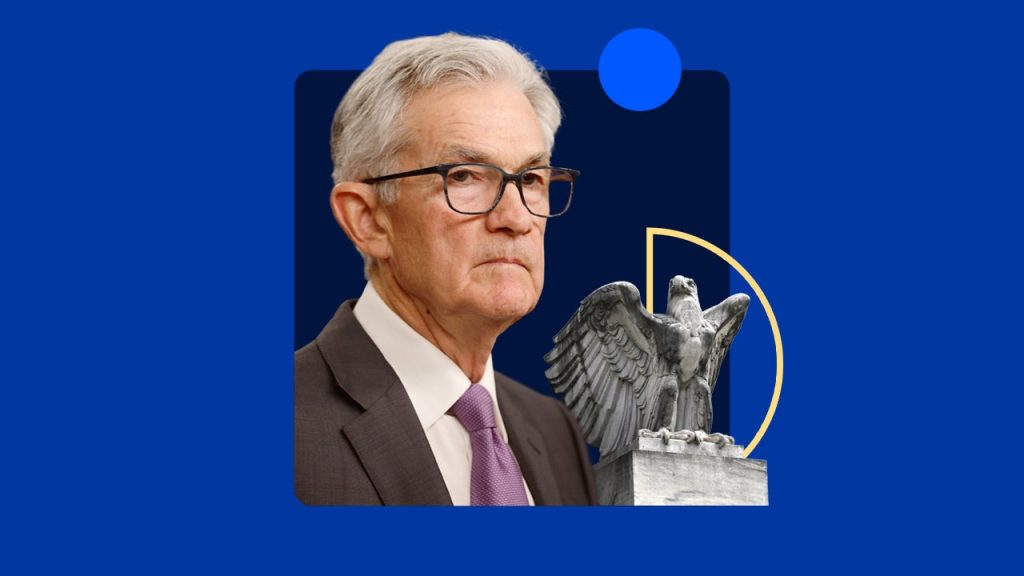While the U.S. economy rebounded from the coronavirus pandemic in 2021, the Federal Reserve chose not to raise rates as inflation topped its official 2 percent target, then doubled it, then tripled it, then quadrupled it — believing those price increases would be only a temporary burden thanks to a global supply chain disruption.
The idea that inflation would eventually fade was perhaps one of the biggest blunders for the modern U.S. central bank, according to many of the economists and historians who study it.
And as officials embark on a new era — cutting interest rates for the first time since 2020 — at their next Federal Open Market Committee (FOMC) gathering on Sept. 17-18, the Fed’s past mistake is haunting investors and economists. Their biggest fear: Could the Fed, once again, be late to react to an economy that needs saving?
“The Fed was behind in recognizing and reacting to inflation, but they did eventually get caught up and so far so good,” says Greg McBride, CFA, Bankrate chief financial analyst. “They have to do the same thing on the way down.”
The Fed has kept its key benchmark federal funds rate at a 23-year high since July 2023, even as unemployment has been steadily increasing. Two days after Fed officials decided in July that they could wait a little bit longer before cutting interest rates, an employment report revealed that joblessness in the month had surged to a three-year high of 4.3 percent. Unemployment has since edged lower to 4.2 percent, but the share of workers out of a job and actively looking for their next gig is still higher than it was immediately before the pandemic.
The Fed’s chances of defeating inflation without causing a recession are still looking good, according to economists, financial analysts and former Fed staffers interviewed by Bankrate. Yet, the slowdown in the job market is an early warning signal that interest rates are now too high, they also say.
Cutting interest rates at this point is not about pressing on the gas pedal, it’s about lifting the foot off the break. We’re entering a falling-rate environment, but that doesn’t mean we’ll be in, or even end up in, a low-rate environment.
— Greg McBride, CFA , chief financial analyst for Bankrate
Rate cuts from the Fed ripple through the economy and straight to your wallet, translating to subsequent decreases in the yields you earn on savings accounts and certificates of deposit (CD), as well as the price you pay to borrow money on everything from a car loan to a credit card.
Here are three key questions surrounding the Fed’s upcoming rate decision this week, including how it could impact your wallet.
1. How much will the Fed cut interest rates in September?
Economists say the Fed has two main options for its first interest rate cut: It can reduce borrowing costs by a smaller quarter of a percentage point — or it can opt with a bigger half-point cut out of the gate.
Powell noted as much, keeping his options open in a speech earlier in September in Jackson Hole, Wyoming.
“The time has come for policy to adjust,” Powell said. “The direction of travel is clear, and the timing and pace of rate cuts will depend on incoming data, the evolving outlook and the balance of risks.”
There will be a lot for the Fed to consider at its September meeting. If policymakers push for aggressive rate cuts, they may appear panicked about the direction of the economy. Monetary policy can also take a full year, if not more, to work its way through the world’s largest financial system. Those lag times might be enough of a reason to go big, especially if it could prevent the slowdown in the financial system from getting worse.
“A case could be made either way,” McBride says. “The economy is not falling apart, but the case for a 50 basis point cut is to take out some insurance, so the Fed isn’t falling behind the curve.”
History may indicate which path the Fed ends up taking. When the Fed was responding to inflation with rate hikes in 2022, Fed officials decided to move first by a quarter point, even if it later meant following up with larger half- and three-quarter point increases down the line.
Going smaller at first eases markets into a regime shift, according to Kristina Hooper, chief global market strategist at Invesco.
“They were clearly behind the curve then,” Hooper says. “I do think they’re behind the curve (now), but I don’t know if they’re as behind as they were on the way up. The Fed should have cut in July, but I don’t think it’s done irreparable damage by waiting until now.”
Fed officials may also just let economic data do the talking. Inflation in August fell to the lowest level since February 2021, long before the worst inflation crisis in 40 years was on U.S. central bankers’ radars. Even so, a measure of inflation that strips out volatile food and energy prices stayed stubborn last month, holding at 3.2 percent for the second month in a row and picking up speed from the prior month, Bureau of Labor Statistics data showed. Coupled with a jobs report that only slightly missed expectations, Fed officials might think a smaller quarter-point cut is best for the economy.
Meanwhile, longer-term interest rates that rise and fall because of investors’ interest rate expectations are reflecting 1.5 percentage points worth of rate cuts. That’s already helped deliver lower borrowing costs to households. The average 30-year fixed-rate mortgage hit a new low for the year of 6.31 percent in the week that ended on Sept. 11, according to Bankrate’s survey of lenders.
“Even before the inflation report, there was not a high probability of a 50 basis point rate cut,” says Preston Caldwell, senior U.S. economist at Morningstar. “That’d be out of step with the Fed’s more cautious behavior over the course of this cycle. It took them a while to even acknowledge the possibility of imminent rate cuts.”
Investors, however, are thinking there could still be a chance of a bigger cut. As of Friday trading, market participants were estimating a 49 percent chance of a half-point cut in September, according to CME Group’s FedWatch tool.
2. How low will interest rates go?
Fed officials’ “pens” can sometimes be mightier than the “sword” of interest rates. That’s because policymakers’ comments about borrowing costs influence investors’ interest rate expectations, meaning financial markets can often reflect the promise of rate cuts long before Fed officials have followed through.
Indeed, Fed officials are expected to signal more rate cuts are coming in an update to their quarterly Summary of Economic Projections (SEP). Investors are bound to take note.
“In and of itself, it’s not going to be a panacea for the economy,” McBride says of the first rate cut. “It’s the first in what will be a series of rate cuts.”
How low rates fall largely depends on how the U.S. economy evolves. Powell has previously suggested that officials may feel their way through the process, cutting interest rates and then taking some time to observe how it impacts the economy. Yet, that was before officials started to hint that their employment goals are starting to outweigh their inflation concerns.
It seems unlikely that the labor market will be a source of elevated inflationary pressures anytime soon. We do not seek or welcome further cooling in labor market conditions.
— Jerome Powell, Federal Reserve Chairman
Previous projections from June showed that the Fed preferred a fed funds rate in a target range of 4-4.25 percent by the time the unemployment rate hit 4.2 percent. Unemployment is now there, but interest rates are still more than a percentage point higher.
“They could get to a comparable level on the fed funds rate by the time the ball drops and rings in 2025,” McBride says.
After their September gathering, the FOMC meets two more times: in November and December. If Fed officials indeed cut by a quarter point this month, a fed funds rate with a target range of 4-4.25 percent by the end of the year would require two half-point cuts.
Another forecast, Morningstar’s Caldwell expects that the Fed will cut 25 basis points at every meeting until the middle of 2025. He’s currently forecasting a 3-3.25 percent fed funds rate by the end of next year.
3. Is the Fed behind the curve?
For now, rate cuts aren’t about giving the economy more juice but instead dialing back the level of restraint the Fed is currently exerting on the U.S. economy.
Data has been mixed, but the conflicting data points roughly tell the same story: The economy is slowing but not falling off a cliff.
Job growth has cooled markedly since the start of the year. The three-month moving average dipped to 116,000 jobs — the lowest since the economy plunged into the depths of the pandemic and down from 243,000 in January. Yet, employers also created 142,000 jobs last month, an amount that would’ve been considered healthy pre-pandemic. Layoffs remain historically low, separate Department of Labor data shows.
A look at the Fed’s benchmark rate minus inflation shows that borrowing costs are the most restrictive since 2007, a Bankrate analysis shows.
“The longer we keep rates at these levels, the more recession risks grow,” Hooper says. Despite lags in monetary policy, she adds that lower interest rates could still be successful in preventing a broader slowdown because many firms have been holding off on hiring until economic uncertainty passes. “I am confident that the Fed will not create a recession and we’ll have a relatively soft landing.”
What the Fed’s rate cut means for your money
Fed policy may be changing directions, but your financial strategy shouldn’t. Interest rates might not remain at a two-decade high for much longer, but they’re expected to remain historically pricey. Before the pandemic, Fed officials were barely able to lift interest rates to 2.25-2.5 percent.
- Keep paying down high-cost debt: High-interest credit card debt is costly, even during periods when interest rates are low. Rate cuts aren’t going to fall far enough or fast enough to bail you out, McBride says. Craft a debt payoff plan and consider applying for a balance-transfer card if the fees associated with consolidating your balance don’t outweigh the amount of money you could save in interest.
- Think twice about big-ticket purchases: Americans can’t always time the market, but waiting to finance a big-ticket purchase may pay off in a falling-rate environment. And if you locked in a loan when interest rates were at their peaks, consider keeping an eye on any refinance opportunities. As always, calculate the fees and compare offers from at least three lenders. If you can lock in an interest rate that’s at least half a percentage point lower than what you’re currently paying, it’s a wise idea to see how quickly you might recoup the cost.
- If you can lock away the cash, consider a CD: The top-yielding 5- and 2-year certificates of deposit (CDs) are already drifting lower as the Fed gears up to cut interest rates. Yet, yields are likely to remain higher than inflation, giving savers an opportunity to keep growing their wealth with a predictable stream of income.
- Prioritize saving for the unexpected: The Fed’s chances of avoiding a recession certainly look brighter than they did back in the summer of 2022, but the Fed has failed to get policy right before. As the economy slows and the Fed seeks to prevent a broader slowdown, consumers should prioritize saving any little bit that they can for the unexpected. A high-yield online bank where those deposits are liquid and FDIC-insured can help you grow that rainy-day fund even faster.
“The stakes are high,” McBride says. “If they get it right, the soft landing means continued economic expansion and low unemployment. If they move too fast in reducing rates, it could let the inflation genie out of the bottle. And if they move too slowly in reducing rates, then that could bring on a much sharper economic downturn.”
Read the full article here
















